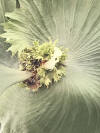 The
photo on the right illustrates how vertical the shield fronds grow.
This is a young P. wandae, but the vertical characteristic is
well displayed. It looks like the fertile fronds have are just
strting to form. The
photo on the right illustrates how vertical the shield fronds grow.
This is a young P. wandae, but the vertical characteristic is
well displayed. It looks like the fertile fronds have are just
strting to form. Roy Vail reports that the P. wandae grows fertile fronds at
a younger age than any of the other giant platyceriums.
Roy Vail reports that the P. wandae grows fertile fronds at
a younger age than any of the other giant platyceriums.
On the left you can observe the frills that grow around the growth
bud. Click on photo for a larger image. The photos left and
right were taken at Gardens By The Bay, Singapore, 2019.
P. wandae likes temperatures between 60 F and 100 F.
It will tolerate cold temperatures for a short period, but damage will
occur below 40 F. Like the P. superbum, it likes
bright filtered shade, mort than most other platyceriums but should be grown in a greenhouse to keep the
humidity high and eliminate extreme temperatures.

This left photo is the best photo I have seen showing how there are
two lobes with spore patches. The main spore patch is lower with
long fronds hanging down. The smaller one is elevated above the
larger and has shorter fronds hanging down. You can click on the photo to see a larger image.
Photo from Platycerium Shop via Facebook  The right lower photo also shows two spore patches, however they are
old and have turned brown. Notice how they are on top of each
other.
The right lower photo also shows two spore patches, however they are
old and have turned brown. Notice how they are on top of each
other. Photo is from Chien Lee via Facebook
 This
photo on the left is from Don Callard's collection in San Diego. It is
a P. superbum with 2 fertile fronds with on spore patch on each frond.
What makes this interesting is the shield frond is that of a P.
wandae. It is not known if this is a cultivar of P. superbum, a
hybrid of wandae x superbum, or possibly something else. Click
on photo for a larger image. This
photo on the left is from Don Callard's collection in San Diego. It is
a P. superbum with 2 fertile fronds with on spore patch on each frond.
What makes this interesting is the shield frond is that of a P.
wandae. It is not known if this is a cultivar of P. superbum, a
hybrid of wandae x superbum, or possibly something else. Click
on photo for a larger image. |